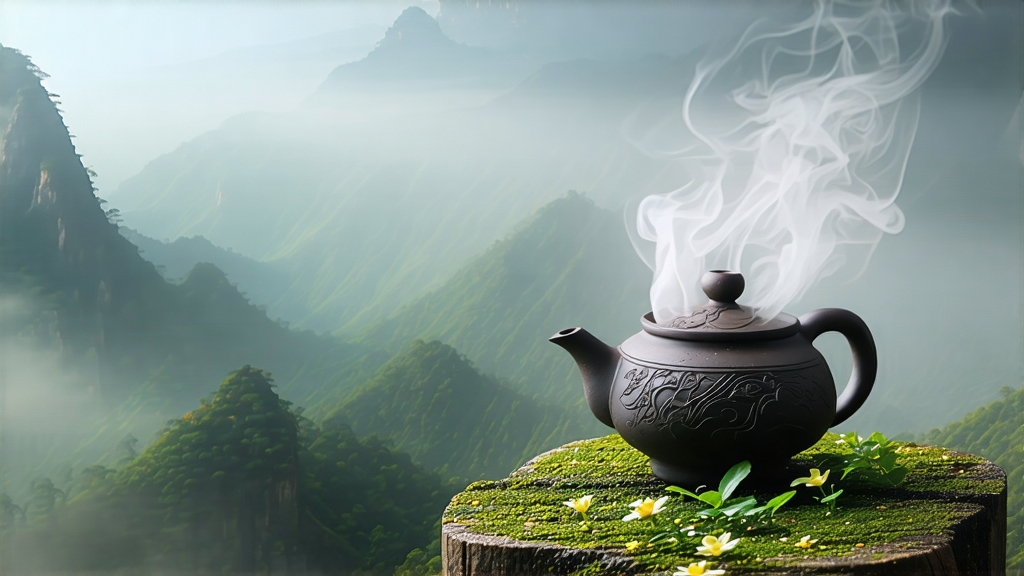
Tucked into the cloud-veiled folds of north-western Hunan, the small county of Anhua has been quietly shaping the soul of Chinese dark tea for more than a millennium. While Pu-erh has become a global celebrity, Anhua Dark Tea—Anhua Hei Cha—remains the connoisseur’s whispered secret: a tea whose flavour is coaxed from leaf, microbe, mountain air and time itself. To understand it is to step into a story that begins with Tang dynasty mountain monks and ends, for now, in your own teacup.
History: From Frontier Currency to Imperial Tribute
Anhua’s tea first enters written record in 816 CE, when Tang court chroniclers noted that “the people of Tanzhou (modern Changsha) barter tea for horses with the Bo and Liao tribes.” The rugged Miao and Tujia villages surrounding Anhua produced leaf so dark and hardy it survived the long, humid trek to the Tibetan plateau, becoming a staple of the ancient Tea Horse Road. By the Ming dynasty the imperial court, anxious to keep war-horses flowing, designated Anhua the official production centre of biancha—“border tea”—and built tax stations along the Zi River to control every brick. Caravans measured their journey not in kilometres but in tea cakes: one compressed 2 kg brick could buy a sturdy horse in Lhasa.
When the Qing opened the port of Hankou to foreign trade in 1861, Anhua bricks rode steamers down the Yangtze to Saint Petersburg and London, where Victorians christened it “brick tea” and marvelled at its malty sweetness. The 20th century brought wars and revolution; tea gardens were abandoned, recipes nearly lost. Yet in 2008 Anhua Dark Tea was granted National Geographical Indication status, and today small family workshops share steam-filled rooms with state-of-the-art clean rooms where stainless-steel sensors track humidity to the decimal point.
Terroir: Where Mist Writes Poetry on Leaf
Anhua sits at the northern edge of China’s subtropical belt, where the 1,500-metre peaks of the Wuling Range trap monsoon clouds between the Zi and Tao Rivers. The result is a year-round fog bank that filters sunlight into a soft, shifting chiaroscuro. Camellia sinensis var. sinensis bushes here root in granite-derived sandy loam laced with selenium and zinc; cool nights slow growth, concentrating amino acids while keeping tannins gentle. Locals insist the tea’s signature “pine-smoke, honey, dried jujube” triad is impossible to replicate beyond these watersheds—a claim supported by repeated transplant failures in Guangxi and Yunnan.
Varietals: Three Bricks and a Roll
Anhua Dark Tea is not a single style but a quartet of shapes, each with its own microbial choreography.
-
Hua Juan (Floral Tribute)
Hand-wrapped in layers of bamboo bark, this 1 kg “roll” is steamed, compressed, then left to ferment inside its vegetal cocoon for up to three years. The bamboo imparts a faint green-bean sweetness; the core darkens to a chocolate-brown spiral shot with golden veins. -
Fu Zhuan (Fu Brick)
The most celebrated style, recognisable by the tiny yellow flecks—eurotium cristatum—that bloom across the broken leaf. These “golden flowers” (jin hua) metabolise polysaccharides into mellow polyols, yielding a liquor reminiscent of cocoa nib and roasted sweet potato. Traditional Fu bricks weigh 2 kg and are stamped with the reign mark of the producing workshop; modern mini-bricks of 200 g cater to urban gongfu drinkers. -
Hei Zhuan (Dark Brick)
A denser, smoke-kissed brick originally created for the Mongolian market. Seven days of pine-fire drying give it a campfire nose that softens into prune and nutmeg in the cup. -
Hua Zhuan (Floral Brick)
A hybrid between Fu and Hei styles: half the batch is inoculated with golden flowers, the other half smoke-cured, then pressed together so that each slice reveals a marbled pattern of light and dark layers.
Craft: The Art of Letting Leaf Rot Correctly
Anhua’s post-fermentation is a duet between human intention and microbial improvisation. The season begins around Grain Rain, when only the standard-leaf “one bud with three or four leaves” is plucked. After withering under mountain breeze for four